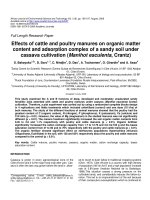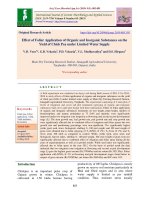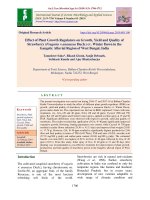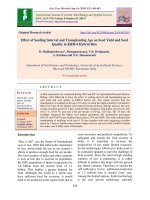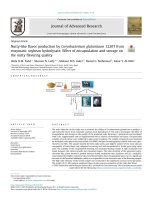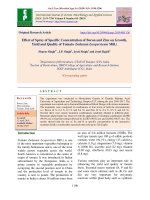Effect of organic manures on quality and shelf life of Beet Root Cv. Crimson Globe
Bạn đang xem bản rút gọn của tài liệu. Xem và tải ngay bản đầy đủ của tài liệu tại đây (220.38 KB, 7 trang )
Int.J.Curr.Microbiol.App.Sci (2018) 7(11): 3615-3621
International Journal of Current Microbiology and Applied Sciences
ISSN: 2319-7706 Volume 7 Number 11 (2018)
Journal homepage:
Original Research Article
/>
Effect of Organic Manures on Quality and Shelf Life of
Beet Root Cv. Crimson Globe
Chitti Jagadeesh*, M. Madhavi, V.V. Padmaja and M. Siva Prasad
Department of Vegetable Science, College of Horticulture, Dr.Y.S.R. Horticultural University,
Mojerla, Mahabubnagar, India
*Corresponding author
ABSTRACT
Keywords
Betanine content,
TSS , Reducing
sugars, Nonreducing sugars,
Total sugars ,
Storage life
Article Info
Accepted:
28 October 2018
Available Online:
10 November 2018
Beetroot (Beta vulgaris L.), also called as garden beet or table beet, is one of the major
root vegetable. It is grown in almost all states of India but in small scale only. It produces
green tops and a swollen root used both as vegetable and salad. It is highly productive and
usually free from pests and diseases (Ado, 1999). A field experiment was conducted
during rabi, 2014 in alkali soils. The experiment was laid out in a randomized block
design with three replicated 11 treatments viz., T1: FYM (100%), T2: Vermicompost
(100%), T3: Neem cake (100%), T4: Poultry manure (100%), T 5: Green manure (100%),
T6: FYM (50%) + Vermicompost (50%), T 7: FYM (50%) + Neem cake (50%), T 8: FYM
(50%) + Poultry manure (50%), T 9: FYM (50%) + Green manure (50%), T 10: RDF, T11:
Control. The data were recorded on betanine content (mg 100g -1), TSS (°Brix), reducing
sugars (%), non-reducing sugars (%), total sugars (%), storage life (days). Whereas FYM
(50%) in combination with neem cake (50%) recorded maximum values for betanin
content, reducing, non-reducing and total sugars. The highest TSS of root was with neem
cake (100%). However, the higher net returns and BCR were obtained with poultry
manure (100%).
Introduction
Beetroot (Beta vulgaris L.), also called as
garden beet or table beet, is one of the major
root vegetable belongs to the family
Chenopodiaceae along with spinach, palak,
swiss chard, parsley, celery and it has
chromosome number of 2n=18. Beet
originated in Western Europe and North
Africa where they were grown to feed both
humans and livestock. This crop is a biennial
grown as a cool season annual. It is grown in
northern and southern parts of India. It is
grown in almost all states of India but in small
scale only. It produces green tops and a
swollen root used both as vegetable and salad.
It is highly productive and usually free from
pests and diseases (Ado, 1999). It is a rich
source of protein, carbohydrate, calcium,
phosphorous and vitamin C, hence it is an
ideal vegetable for health conscious people
(Deuter and Grundy, 2004). Red color of roots
is due to presence of betanine pigment.
Beet root helps to reduce blood pressure,
prevents plaque formation and reduces bad
3615
Int.J.Curr.Microbiol.App.Sci (2018) 7(11): 3615-3621
cholesterol, keeps diabetes under check, treats
anaemia, helps to relieve fatigue, improves
sexual health and stamina, protects from
cancer, etc. Among the many constraints to
increase productivity in beet root, inorganic
nutrition is the main limiting factor especially
in alkaline soils. The continuous use of
inorganic fertilizers is adversely affecting the
sustainability of production besides causing
environmental pollution. In view of increased
awareness about organic manuring, increased
availability
of
organic
inputs
and
sustainability in the farm, investigation on
these aspects have thus become imperative to
study and assess their effect on quality and
shelf-life of beet root. Hence, this
investigation is planned to identify effect of
organic manures on quality and shelf life of
beet root grown in alkali soils.
Materials and Methods
A field experiment was conducted during rabi,
2014 in alkali soils, at college farm, College of
Horticulture, Dr. Y.S.R. Horticultural
University, Mojerla, Mahabubnagar(Dt). The
experiment was laid out in a randomized block
design with three replicated 11 treatments viz.,
T1: FYM (100%), T2: Vermicompost (100%),
T3: Neem cake (100%), T4: Poultry manure
(100%), T5: Green manure (100%), T6: FYM
(50%) + Vermicompost (50%), T7: FYM
(50%) + Neem cake (50%), T8: FYM (50%) +
Poultry manure (50%), T9: FYM (50%) +
Green manure (50%), T10: RDF, T11: Control.
The data were recorded on betanine content
(mg 100g-1), TSS (°Brix), reducing sugars
(%), non-reducing sugars (%), total sugars
(%), storage life (days).
Root quality parameters
Total soluble solids and reducing sugars
The total soluble solids of all the roots of five
randomly selected plants from each plot was
measured with the help of a hand
refractometer (0-280 B) and the average is
expressed in 0Brix. Reducing sugars were
determined by the method of Lane and Eyon
(AOAC, 1965). Ten grams of beetroot cube
was taken, ground well and transferred to 250
ml volumetric flask and 2 ml of lead acetate
solution (45 %) was added to the flask to
precipitate colloidal matter and kept for 24
hrs. Two ml potassium oxalate (22%) was
added to this solution to precipitate the lead
acetate and the volume was made up to 250 ml
using distilled water. The contents were then
filtered through Whatman No.1 filter paper
after testing a little of filtrate for absence of
lead by adding a drop of potassium oxalate.
Reducing sugars in the filtrate were estimated
by titrating against 10 ml of standard
Fehling’s solution mixture of A and B (1:1)
using methylene blue as an indicator till the
end point was indicated by the formation of
brick red precipitate.
The titration was carried out by keeping the
Fehling’s solution boiling on the heating
mantle. The results were expressed as per cent
reducing sugar.
Reducing sugars (%) =
Titre value × Weight of sample
× 100
Factor value × Dilution
Total sugars (%)
Total sugars were determined by the method
described by Lane and Eyon (AOAC, 1965).
A quantity (50 ml) of lead free filtrate was
taken in a 100 ml volumetric flask and to it 5
ml of concentrated HCl was added, mixed
well and then kept for 24 hours at ambient
temperature. Acid was then neutralized with
40% NaOH using a drop of phenolphthalein as
an indicator till the pink colour persisted a few
seconds. The volume was then made up to 100
ml with distilled water. Total sugars were
estimated by titrating against standard
3616
Int.J.Curr.Microbiol.App.Sci (2018) 7(11): 3615-3621
Fehling’s solution mixture of A and B (1:1)
using methylene blue as an indicator till it
turns to brick red colour as an end point. The
results were expressed as per cent total sugar.
Total sugars (%) =
Titre value × Weight of sample × Aliquot
× 100
Shelf life (days)
The harvested roots were kept for shelf life
studies in a laboratory at ambient
temperatures. Shelf life of roots was assessed
in days based on visual parameters. The
number of days was computed from the day of
harvest till the root remains in fresh condition
and acceptable to the consumer.
Factor value × Dilution 1 × Dilution 2
Results and Discussion
Non-reducing sugars (%)
Non-reducing sugars were estimated by
subtracting reducing sugars from total sugars
and expressed as per cent. Non-reducing
sugars (%) = Total sugars (%) - Reducing
sugars (%)
The effect of different organic manures viz,
FYM, vermicompost, poultry manure, neem
cake and green manure at various stages of
crop growth in Beetroot with respect to quality
is studied. The results of the present
investigation on the above aspect are
presented hereunder.
Ascorbic acid (mg 100-1 g)
Quality parameters
Ten grams of beetroot cube was ground well
with 3 per cent metaphosphoric acid and the
volume was made up to 100 ml with 3 per cent
metaphosphoric acid. The contents were
shaken well and filtered through filter paper.
10 ml of the aliquot was taken and titrated
against
standard dye solution
(2,6dichlorophenol indophenol dye) till the light
pink colour persisted for at least 15 seconds
(Ranganna, 1986). The ascorbic acid content
was estimated using the given formula and
expressed as mg/100g of plant material.
Ascorbic acid (mg 100g-1) =
Titre value × dye factor × volume made up
Aliquot taken × weight of the sample
Betanine (mg 100-1 g)
Betanine content of roots was determined at
harvest with the procedure suggested by
Nilsson (1970) and was expressed in mg 100
g-1 sample.
Data on various quality parameters of beetroot
crop as influenced by the different organic
manures and their combinations are presented
in Tables 1 and 2.
Betanine content (mg 100g-1)
The Betanine content of beetroot roots was
significantly affected by the different
treatments applied to the experiment. The
results are presented in Table 1.
The highest betanine (1.93) was recorded in T7
with the application of FYM (50%) + Neem
cake (50%) which was on par with T3 (1.89)
with Neem cake (100%), T6 with FYM (50%)
+ vermicompost (50%) and T8 with FYM
(50%) + poultry manure (50%) which were
significantly superior to all other treatments.
The lowest betanine content (4.30) was
recorded in control RDF @ 70 kg N; 110 kg
P2O5; 70 kg K2O recorded betanine content of
1.61.
3617
Int.J.Curr.Microbiol.App.Sci (2018) 7(11): 3615-3621
Total soluble solids (°Brix)
The TSS of beetroot roots was significantly
affected by the application of Neem cake
(100%).The results are presented in Table
1.The highest TSS (8.64) was recorded in T3
with the application of neem cake (100%)
followed by T7 (8.29) with FYM (50%) +
Neem cake (50%) which were significantly
superior to all other treatments. The lowest
TSS content (6.23) was recorded in Control
(T11).
cake, poultry manure and green manure. The
results are presented in Table 2. The highest
non-reducing sugars content (2.26) was
recorded in T7 with the application of FYM
(50%) + Neem cake (50%) which was at par
with T6 (2.23) with FYM (50%) +
Vermicompost (50%) and were significantly
superior to all other treatments. The lowest
non-reducing sugar content (1.78) was
recorded in FYM (50%) + green manure
(50%) and was on par with T10 (1.81), T9
(1.78), T5 (1.86) and T2 (1.88).
Ascorbic acid (mg 100-1 g fresh weight)
Total sugars (%)
The Ascorbic acid of beet root roots was
significantly affected by the application of
vermicompost (100%) and FYM (50%) +
Poultry Manure (50%). The results are
presented in Table 1. The highest ascorbic
acid (3.31) was recorded in T2 with the
application of Vermicompost (100%) which
was at par (3.28) of T8 with FYM (50%) +
Poultry Manure (50%) and were significantly
superior to all other treatments. The lowest
ascorbic acid content (2.50) was recorded in
Control (T11).
The total sugars content of beetroot roots was
significantly affected by the application of
FYM, vermicompost, neem cake, poultry
manure and green manure. The results are
presented in Table 2.The highest total sugar
content (7.40) was recorded in T7 with the
application of FYM (50%) + Neem cake
(50%) which was at par with T6 (7.33) with
FYM (50%) + Vermicompost (50%) and were
significantly superior to all other treatments.
The lowest total sugars content (6.43) was
recorded in control, which was on par with T10
(6.45), T9 (6.48), T5 (6.50) and T2 (6.54).
Reducing sugars (%)
The reducing sugars content of beet root roots
was significantly affected by the application of
FYM (50%) + Neem cake (50%). The results
are presented in Table 2. The highest reducing
sugars content (5.15) was recorded in T7 with
the application of FYM (50%) + Neem cake
(50%) which was at par with T6 (5.10) with
FYM (50%) + Vermiompost (50%) and were
significantly superior to all other treatments.
The lowest reducing sugar content (4.58) was
recorded in Control (T11).
Non-reducing sugars (%)
The non-reducing sugars content of beetroot
roots was significantly affected by the
application of FYM, vermicompost, neem
Improvement in quality of beetroot with the
application of organic manures over inorganic
fertilizers was observed. The betanin (1.93 mg
100g-1), TSS (8.64 °Brix), ascorbic acid (3.31)
were higher with the application of FYM (50%)
+ poultry manure (50%) and sole application of
neemcake (100%), vermicompost (100%)
respectively, Reducing sugars (5.15%), nonreducing sugars (2.26%) and total sugars content
(7.40%) were higher with the application of
neem cake in combination with FYM. This may
be because of better availability and uptake of
nitrogen and other nutrients with the application
of manures which might have lead to balanced
C/N ratio and increased activity of plant
metabolism. Similar findings were made by
Singh et al., (1970), Matura (1961) and Emura
and Hosoya (1979) in carrot.
3618
Int.J.Curr.Microbiol.App.Sci (2018) 7(11): 3615-3621
Table.1 Effect of different organic manures on betanine content (mg 100g-1), TSS (%) and
ascorbic acid (mg 100g-1) of Beet root at harvest
Treatments
T1 : FYM (100%)
T2 : Vermicompost (100%)
T3 : Neem cake (100%)
T4 : Poultry Manure (100%)
T5 : Green Manure (100%)
T6 : FYM (50%) + Vermicompost (50%)
T7 : FYM (50%) + Neem cake (50%)
T8 : FYM (50%) + Poultry Manure (50%)
T9 : FYM (50%) + Green Manure (50%)
T10: RDF @ 70 kg N; 110 kg P2O5; 70 kg K2O
T11: Control
Betanine
1.76
1.75
1.89
1.72
1.71
1.83
1.93
1.81
1.65
1.61
1.54
TSS
7.84
8.05
8.64
8.17
7.38
8.09
8.29
7.74
7.54
7.01
6.23
Ascorbic acid
2.87
3.31
2.90
2.87
2.90
2.80
2.76
3.28
2.81
2.56
2.50
0.14
0.24
0.17
0.05
0.08
0.06
CD at 5%
SE(m) ±
Table.2 Effect of different organic manures on Sugars (%) and
storage life (days) of Beet root at harvest
Treatments
T1 : FYM (100%)
T2 : Vermicompost (100%)
T3 : Neem cake (100%)
T4 : Poultry Manure (100%)
T5 : Green Manure (100%)
T6 : FYM (50%) + Vermicompost (50%)
T7 : FYM (50%) + Neem cake (50%)
T8 : FYM (50%) + Poultry Manure (50%)
T9 : FYM (50%) + Green Manure (50%)
T10: RDF @ 70 kg N; 110 kg P2O5; 70 kg K2O
T11: Control
CD at 5%
SE(m) ±
3619
Reducing
Sugars
4.70
4.66
4.93
4.87
4.65
5.10
5.15
4.88
4.71
4.64
4.58
0.14
Nonreducing
2.01
Sugars
1.88
2.10
2.00
1.86
2.23
2.26
2.09
1.78
1.81
1.85
0.16
Total
Sugars
6.70
6.54
7.02
6.87
6.50
7.33
7.40
6.97
6.48
6.45
6.43
0.25
Shelf life
0.05
0.06
0.09
0.17
3.10
4.43
2.76
3.20
3.43
4.10
3.76
3.10
3.43
3.10
2.60
0.51
Int.J.Curr.Microbiol.App.Sci (2018) 7(11): 3615-3621
Indumati (2000) reported an increase in TSS
content with the application of vermicompost
besides other organic manures and with
recommended dose of fertilizers in radish.
Kolodzieg and Kostecka (1994) also observed
better root quality when carrot was grown
with vermicompost than mineral fertilizers.
Increase in carotene content with the
increasing dosage of vermicompost was also
reported by Ravindrababu (1999). Hallmann
(2012) showed an increase in the total content
of sugars and in a higher sugar to organic
acids ratio in organic tomatoes when
compared to these produced conventionally.
Rembiałkowska et al., (2012) confirmed a
higher content of total sugars in organic fruits
and vegetables, including carrots, beets,
potatoes, spinach, kale, cherries, black
currants and apples, which contribute to an
increase in the technological and sensory
quality (taste) of organic products.
Kale et al., (1992) observed that
vermicompost application enhanced the
activity of beneficial microbes and
colonization of mycorrhizal fungi which play
an important role in mobilization of nutrients
by plants. Thus, leading to better availability
of nutrients and uptake by plants and resulting
in better quality.
In conclusion, all the quality parameters were
improved significantly with the organic
manures over inorganic fertilizers. The
highest betanine (1.93) content was recorded
with FYM (50%) + neem cake (50%) which
was at par (1.89) with neem cake (100%),
FYM (50%) + vermicompost (50%) (1.83)
and FYM (50%) + poultry manure (50%)
(1.81). The highest total soluble solids (8.64)
was recorded with neem cake (100%) which
was at par with FYM (50%) + neem cake
(50%) (8.29). The highest ascorbic acid (3.31)
was recorded with vermicompost (100%)
which was at par with FYM (50%) + poultry
manure (50%) (3.28). The highest reducing
sugars (5.15) was recorded with FYM (50%)
+ neem cake (50%) which was at par (5.10)
with FYM (50%) + Vermicompost (50%).
The highest non reducing sugars (2.26) was
recorded with FYM (50%) + neem cake
(50%) which was at par (2.23) with FYM
(50%) + Vermicompost (50%). The highest
total sugar content (7.40) was recorded with
FYM (50%) + neem cake (50%) which was at
par (7.33) with FYM (50%) + Vermicompost
(50%). Storage life was maximum (4.43 days)
with the application of vermicompost (100%)
which was at par with FYM (50%) +
vermicompost (50%) (4.10 days).
References
Storage life (days)
Ado,
The storage life of Beetroot was significantly
affected by the application of FYM,
vermicompost, neem cake, poultry manure
and green manure. The results are presented
in Table 2. The highest storage life (4.43) was
recorded in T2 with the application of
vermicompost (100%) followed by T6 (4.10)
with vermicompost (50%) + FYM (50%)
which were significantly superior to all other
treatments. The lowest storage life (2.60) was
recorded in control. The higher storage life of
Beetroot
with
the
application
of
vermicompost may be because of low
respiration rate.
P.O., 1999. Beetroot Cultivation.
Beetroot and Eggplant Newsletter, 18:
21 – 24.
Association of Official Agricultural Chemista
(AOAC). 1969. Official and tentative
methods of analysis. Association of
Official
Agricultural
Chemists.
Washington D C.
Deuter, P. and Grundy, T. (2004). Beetroot
Commercial Production and Processing.
Agency for Food and Fibre Sciences.
Holland
Horticultural
Limited
Partnership. P. 1 – 4.
Emura, K and Hosoya, T. 1979. Effect of
3620
Int.J.Curr.Microbiol.App.Sci (2018) 7(11): 3615-3621
fertilization on the quality and yield of
spring sown carrots. Bulletin of the
Saitawa Horticultural Experimental
Station. Pp:13-23. HA: 50(12)- 9153.
Hallmann E, Rembiałkowska E (2012).
Characterisation
of
antioxidant
compounds in sweet bell pepper
(Capsicum annuum L.) under organic
and conventional growing systems. J
Sci Food Agri, DOI 10.1002/jsfa.5624.
Indumathi, S. 2000. Integrated nutrient
management in radish (Raphanus
sativus L.) M.Sc. thesis submitted to
Acharya N. G. Ranga Agricultural
University, Hyderabad.
Kale, R.M, Mallesh, B.C, Bano, K and
Bagyaraj, D.J. 1992. Influence of
vermicompost application on the
available macro nutrients and selected
microbial population in paddy field. Soil
Biology and Biochemistry. 24 (12):
1317-1320.
Kolodzieg, M and Kostecka, J. 1994. Some –
quality characteristics in cucumber and
carrots grown on vermicompost. Zeszyty
- Navkowe – Akademii – Rolniczej. In
Hugona – Kallataja – Krakowie – Sesja
– Naukowa. 41 : 89-93.
Matura, H. 1961. A study on year round
cultured vegetables containing pigments
other than chlorophyll.
Nilsson. T. 1970. Studies in to the pigments in
beetroot (Beta vulgaris L. ssp. Vulgaris
var. rubra L.) Lantbrukshogsk Ann. 36:
179-197.
Ranganna. S. 1994. Hand book of analysis
and quality control for fruits and
vegetable products. Tata McGraw Hill
Publishing Company limited. New
Delhi.
Ravindrababu, M. 1999. Studies on integrated
nutrient
management
with
vermicompost and inorganic fertilizers
in carrot (Dacus carota L.). M.Sc.
Thesis submitted to Acharya N. G.
Ranga Agricultural University
Singh, K, Gill, J.S and Verma, O.P. 1970.
Studies on poultry manure in relation to
vegetable production. Indian Journal of
Horticulture. 27- 42-47.
How to cite this article:
Chitti Jagadeesh, M. Madhavi, V.V. Padmaja and Siva Prasad, M. 2018. Effect of Organic
Manures on Quality and Shelf Life of Beet Root Cv. Crimson Globe.
Int.J.Curr.Microbiol.App.Sci. 7(11): 3615-3621. doi: />
3621
